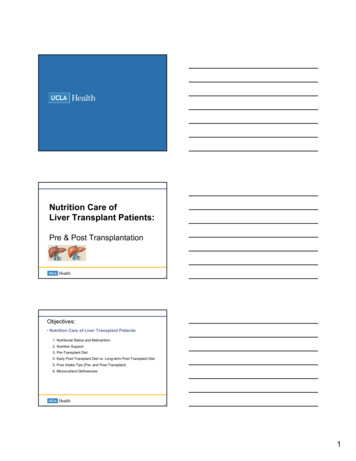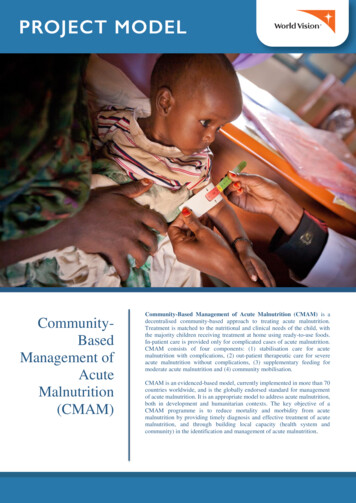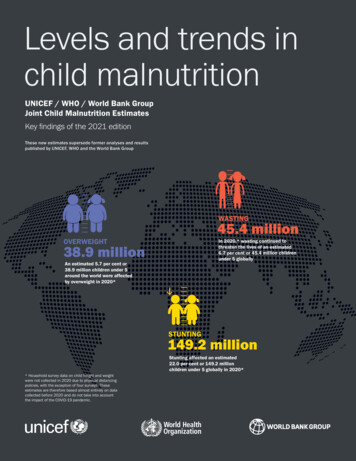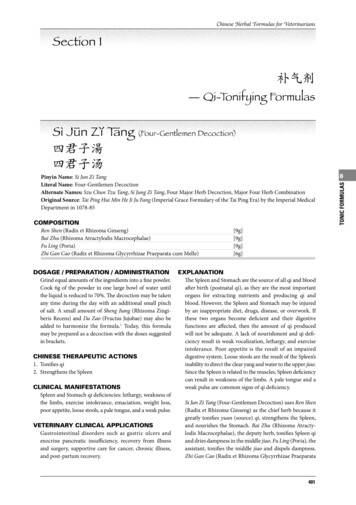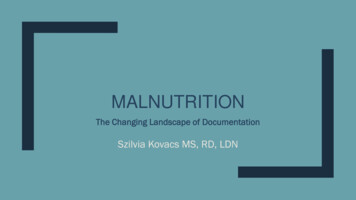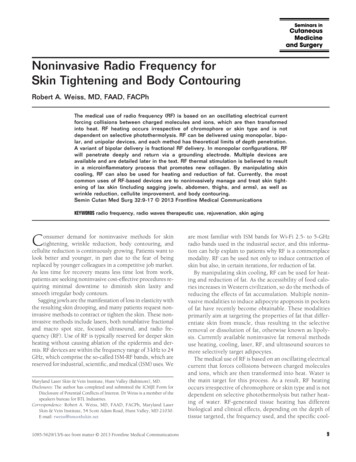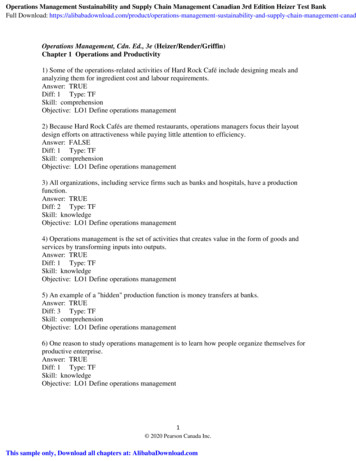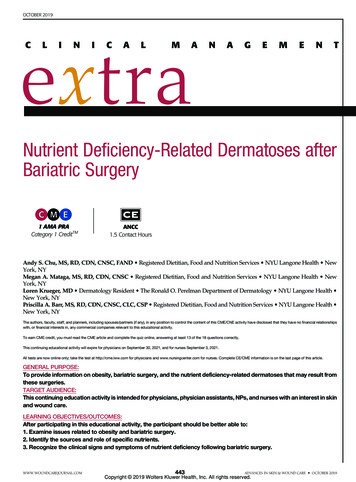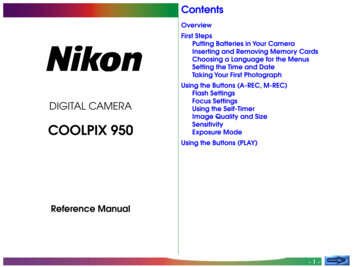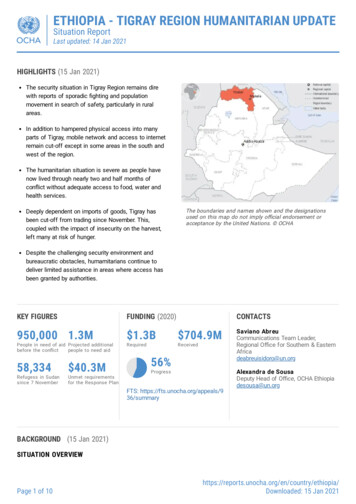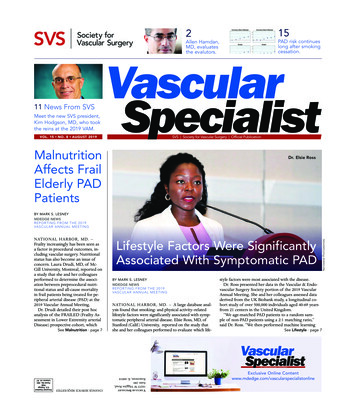
Transcription
2Allen Hamdan,MD, evaluatesthe evalutors.15PAD risk continueslong after smokingcessation.11 News From SVSMeet the new SVS president,Kim Hodgson, MD, who tookthe reins at the 2019 VAM.VOL. 15 NO. 8 AUGUST 2019MalnutritionAffects FrailElderly PADPatientsDr. Elsie RossSee Malnutrition · page 7Lifestyle Factors Were SignificantlyAssociated With Symptomatic PADBY MARK S. LESNEYMDEDGE NEWSREP OR T I N G F ROM T H E 2019VAS C U L AR AN N U AL ME E T I N GNATIONAL HARBOR, MD. – A large database analysis found that smoking- and physical activity–relatedlifestyle factors were significantly associated with symptomatic peripheral arterial disease. Elsie Ross, MD, ofStanford (Calif.) University, reported on the study thatshe and her colleagues performed to evaluate which life-Vascular specialist10255 W Higgins Road,Suite 280Rosemont, IL 60018NATIONAL HARBOR, MD. –Frailty increasingly has been seen asa factor in procedural outcomes, including vascular surgery. Nutritionalstatus has also become an issue ofconcern. Laura Drudi, MD, of McGill University, Montreal, reported ona study that she and her colleaguesperformed to determine the association between preprocedural nutritional status and all-cause mortalityin frail patients being treated for peripheral arterial disease (PAD) at the2019 Vascular Annual Meeting.Dr. Drudi detailed their post hocanalysis of the FRAILED (Frailty Assessment in Lower Extremity arterialDisease) prospective cohort, whichstyle factors were most associated with the disease.Dr. Ross presented her data in the Vascular & Endovascular Surgery Society portion of the 2019 VascularAnnual Meeting. She and her colleagues assessed dataderived from the UK Biobank study, a longitudinal cohort study of over 500,000 individuals aged 40-69 yearsfrom 21 centers in the United Kingdom.“We age-matched PAD patients to a random sample of non-PAD patients using a 2:1 matching ratio,”said Dr. Ross. “We then performed machine learningSee Lifestyle · page 7Exclusive Online oNwide P hotograPhersBY MARK S. LESNEYMDEDGE NEWSREPOR TING FR O M THE 2 0 1 9VAS CU LAR A N N UA L M E E TIN GCHANGE SERVICE REQUESTEDPresorted StandardU.S. PostagePAIDPermit No. 384Lebanon Jct. KY
GUEST EDITORIALDo we need to re-evaluate the way we evaluate?BY ALLEN D. HAMDAN, MDAlthough vascular surgery has seen dramaticchanges in technology and procedures, theway we give feedback to our trainees hasmainly remained the same. Our evaluation systems, though structured, are cumbersome, and inorder to improve, it may be helpful to look at thefundamental principles used in business and theprivate sector.To start, one key measure of the effectivenessof our current system would be to find out whatour trainees think. As such, information from asurvey of vascular surgery trainees by Dalsing etal. is illustrative ( J Vasc Surg. 2012 Feb;55[2]:58897). Among the key findings for both residents andfellows are the following:1. One of the most critical factors in choosing aresidency is the program director (main person infeedback);2. Tests with subsequent review are considered apoor method of evaluation, whereas direct clinicalfeedback before, during, and after a procedure isvery highly rated;3. Trainees rated most aspects of their currentprogram as excellent. However, “feedback given”was considered only good or fair.Looking outside of surgery for better systems iscritical.A recent article by Buckingham and Goodall inHarvard Business Review (March-April 2019, p.92) sheds light on current best practices. The authors provide evidence from neuroscience researchthat essentially debunks our standard approach ofpraise and “constructive” criticism.Some of the key findings of this paper areinterspersed below, along with lessons learnedVASCULAR SPECIALIST Medical Editor Malachi Sheahan III, MDAssociate Medical Editors Bernadette Aulivola, MD, O. WilliamBrown, MD, Elliot L. Chaikof, MD, PhD, Carlo Dall’Olmo, MD, AlanM. Dietzek, MD, RPVI, FACS, Professor Hans-Henning Eckstein, MD,John F. Eidt, MD, Robert Fitridge, MD, Dennis R. Gable, MD, LindaHarris, MD, Krishna Jain, MD, Larry Kraiss, MD, Joann Lohr, MD,James McKinsey, MD, Joseph Mills, MD, Erica L. Mitchell, MD, MEd,FACS, Leila Mureebe, MD, Frank Pomposelli, MD, David Rigberg,MD, Clifford Sales, MD, Bhagwan Satiani, MD, Larry Scher, MD,Marc Schermerhorn, MD, Murray L. Shames, MD, Niten Singh, MD,Frank J. Veith, MD, Robert Eugene Zierler, MDResident/Fellow Editor Laura Drudi, MD.Executive Director SVS Kenneth M. Slaw, PhD.Interim Director of Membership, Marketing and CommunicationsAngela TaylorManaging Editor SVS Beth BalesVascular Specialist is the official newspaper of the Society for VascularSurgery and provides the vascular specialist with timely and relevantnews and commentary about clinical developments and aboutthe impact of health care policy. Content for Vascular Specialist isprovided by Frontline Medical Communications Inc. Content forthe News From the Society is provided by the Society for VascularSurgery.The ideas and opinions expressed in Vascular Specialist donot necessarily reflect those of the Society or the Publisher.The Society for Vascular Surgery and Frontline MedicalCommunications Inc. will not assume responsibility for damages,loss, or claims of any kind arising from or related to theinformation contained in this publication, including any claimsrelated to the products, drugs, or services mentioned herein.2 VASCULAR SPECIALISTDr. Hamdan is the ViceChair (Director of Operations) Department of Surgery, Beth Israel LaheyHealth; Associate Professor of Surgery, HarvardMedical School; Co-ChairCommittee for SocialResponsibility, Board ofDirectors, Strategic Planning, and Greater BostonFood Bank.rom training residents for 20 years.1. We aren’t as reliable as we think in ratingperformance. We evaluate through the prism ofour experiences and what worked or didn’t forus, as well as unconscious bias. We are excellentat assessing our own feelings and opinions, butnot on judging what someone else may think.Many studies show that we use different wordswhen giving feedback based on the gender of thetrainee.2. Criticism inhibits the brain’s ability to learn.3. Excellence is idiosyncratic and hard to define –we all operate with surgeons who “are just better”and clinicians who are almost never wrong. It isnot just effort and intelligence.4. You cannot correct someone into stardom.5. Feedback in training has become somewhatof a check the box, and a means to itself. This typeof feedback is not always helpful and, thus, oftenmisses the goal.6. Specific instruction in what knowledge and/ortechnical skills need to be acquired is useful. That’swhy checklists work – they are nonjudgmental.7. In businesses that use radical transparency andPOSTMASTER Send changes of address (with old mailing label) toVascular Specialist, Subscription Services, 10255 W. Higgins Road,Suite 280, Rosemont, IL 60018-9914.RECIPIENT: To change your address, contact Subscription Servicesat 1-800-430-5450. For paid subscriptions, single issue purchases,and missing issue claims, call Customer Service at 1-833-836-2705or e-mail custsvc.vasc@fulcoinc.com.The Society for Vascular Surgery headquarters is located at9400 W. Higgins Road, Suite 315, Rosemont, IL 60018.Vascular Specialist (ISSN 1558-0148) is published monthly for theSociety for Vascular Surgery by Frontline Medical CommunicationsInc., 7 Century Drive, Suite 302, Parsippany, NJ 07054-4609.Phone 973-206-3434, fax 973-206-9378Subscription price is 230.00 per year.National Account Manager Valerie Bednarz, 973-206-8954,cell 973-907-0230, vbednarz@mdedge.comDigital Account Manager Amanda Smith, (973) 206-2321,asmith@mdedge.comClassified Sales Representative Drew Endy, 215-657-2319,cell 267-481-0133, dendy@mdedge.comSenior Director of Classified Sales Tim LePella, 484-921-5001,cell 610-506-3474, tlapella@mdedge.comAdvertising Offices 7 Century Drive, Suite 302, Parsippany, NJ07054-4609 973-206-3434, fax 973-206-9378 Copyright 2019, by the Society for Vascular SurgeryScan this QR Code to visitvascularspecialistonline.com360-degree feedback, the results are decidedly negative. Our current standard is similar.8. Excellence is not the opposite of failure, and itcan’t be pinned down. Are we really helping a trainee by telling her she got a 3 on MK1: ProceduralRationale – Basic Procedures (e.g., amputation, basic arteriovenous [AV] fistula/graft, varicose veins,diabetic foot and wound management, placementof inferior vena cava [IVC] filter) instead of a 3.5 orhigher? This method may assess and allow for competency but might not allow for growth. As statedabove – the number is the assessor or assessors’number – not hers. It is probably wrong anyway.The idiosyncratic rater effect is shown to beproblematic in numerous studies. This is similarto “eye witness” accounts of crimes, which can bevery unreliable. We try to mitigate this effect byadding scores from multiple raters and creating anaverage. This practice does not increase the accuracy of a score; rather each individual error is nowmagnified. The most accurate input is likely to befrom someone who best knows the resident’s performance in this domain. This is why the programdirector is so important to the residents whenchoosing a place to train.We also need to understand the differences between remediation and feedback. They have distinct goals and should be conducted independently.As an example, if you explain to the fellow (veryloudly and publicly) that a loss of pulse at 3 AMon a recent bypass should prompt an immediatecall and not be a discovery on 7 AM rounds, realizethis is criticism with an attempt at remediation,not feedback. This is important in setting expectations, but if you start it as an accusation, his orher brain will go into fight or flight and shutdown.Evaluate continued on page 3FRONTLINE MEDICAL COMMUNICATIONS SOCIETY PARTNERSDirector, FMC Society Partners Mark BrancaEditor in Chief Mary Jo M. DalesExecutive Editors Denise Fulton, Kathy ScarbeckManaging Editor Mark S. LesneyCreative Director Louise A. KoenigDirector, Production/Manufacturing Rebecca SlebodnikLetters to the Editor: VascularSpecialist@vascularsociety.orgEditorial Offices: 2275 Research Blvd, Suite 400, Rockville, MD 20850, 240221-2400, fax 240-221-2548FRONTLINE MEDICAL COMMUNICATIONSCorporateSVP, Finance Steven J. ResnickVP, Operations Jim ChiccaVP, Sales Mike GuireVP, Society Partners Mark BrancaVP, Editor in Chief Mary Jo M. DalesVP, Editorial Director, Clinical ContentKaren ClemmentsVP, Digital Content & Strategy Amy PfeifferPresident, Custom Solutions JoAnn WahlVP, Custom Solutions Wendy RaupersVP, Marketing & Customer AdvocacyJim McDonoughVP, Human Resources & Facility OperationsCarolyn CaccavelliData Management Director Mike FritzCirculation Director Jared SonnersCorporate Director, Research & Comms.Lori RaskinDirector, Custom Programs Patrick FinneganIn affiliation with Global Academy for MedicalEducation, LLCPresident David J. Small, MBAAUGUST 2019
CAROTID DISEASE AND STROKEFew Stroke Patients Have Osteoporosis ScreeningBY BIANCA NOGRADYMDEDGE NEWSFROM S TROKEAlthough stroke is a risk factorfor osteoporosis, falls, andfractures, very few peoplewho have experienced a recent strokeare either screened for osteoporosisor treated, research suggests.Writing in Stroke, researcherspresented an analysis of Ontarioregistry data from 16,581 patientswho were aged 65 years or older andpresented with stroke between 2003and 2013.Overall, just 5.1% of patientsunderwent bone mineral densitytesting. Of the 1,577 patients whohad experienced a prior fracture,71 (4.7%) had bone mineral densitytesting, and only 2.9% of those whohad not had prior bone mineral density testing were tested after theirstroke. Bone mineral density testingwas more likely in patients who wereyounger, who were female, and whoexperienced a low-trauma fracture inthe year after their stroke.In total, 15.5% of patients wereprescribed osteoporosis drugs in thefirst year after their stroke. However,only 7.8% of those who had fractures before the stroke and 14.8% ofScreening andtreatment may beparticularly lowbecause of underrecognition ofosteoporosis as aconsequence of stroke.those with fractures after the strokereceived osteoporosis treatment afterthe stroke. Patients who were female,had prior osteoporosis, had experienced prior fracture, had previouslyundergone bone mineral densityEvaluatecontinued from page 2Phrase it as – “What didn’t work in this situationwas the timing, as we could have taken the patientto the OR sooner.”Similar lessons are true with positive feedback. Positive feedback is important but the phrase “you didgreat” is nice for about three seconds. Real feedbackis a comment such as, “It was impressive that youfound the subtle difference in the angiogram fromlast year that allowed us to figure out the best plan.”Or “On that AAA, your understanding of the exposure, the way you used your needle angle and bodyto get those back wall sutures, and your attention towhat anesthesia was doing were all excellent.”Similar lessons have been learned from instruction in sports. With my personal experiencecoaching over 200 girls’ basketball games, I canillustrate this point. If a player doesn’t hustle backon defense, the opposition may score. If you takeher out immediately or yell at her in front of herteammates, she will likely be remediated – i.e., shewill get back on defense because you control herminutes. This, however, does not help her to improve. If she actually gets better, it’s only becauseshe wanted to. However, if in practice you stop thedrill to explain how her effort created a steal forher teammate, she will likely improve and hustlemore. She will also pay closer attention to yourplays. You have taught her how to be a leader onyour defense and help her teammates.Neuroscience shows we grow more in our areas of greatest ability, and different people haveunique synaptic connections. It is easier to learn bybuilding on your strengths than trying somethingAUGUST 2019testing, or had experienced a fractureor fall after their stroke were morelikely to receive osteoporosis pharmacotherapy.The authors found that the neitherthe severity of stroke nor the presence of other comorbidities was associated with an increased likelihoodof screening or treatment of osteoporosis after the stroke.Stroke is associated with up to afourfold increased risk of osteoporosis and fracture, compared withhealthy controls, most probablybecause of reduced mobility and anincreased risk of falls, wrote EshitaKapoor of the department of medicine at the University of Toronto andher coauthors.“Screening and treatment may beparticularly low poststroke becauseof under-recognition of osteoporosis as a consequence of stroke, aselective focus on the managementof cardiovascular risk and stroke recovery, or factors such as dysphagiaprecluding use of oral bisphospho-completely new. For example, just because youread a textbook, took notes, wrote index cards, andcrushed the ABSITE every year – doesn’t meanyou should instruct all of your trainees to do thesame. This feedback to a resident who learns visually is not only useless, it’s potentially harmful.Using functional MRI during problem solvingcan illustrate this further. If you say to a student“What did you do wrong in this instance andhow are you going to correct it?” – the sympa-Help your students andtrainees focus on their wins.When they accomplish atask without assistance askwhy did it work for them.“Yes, that was good” asopposed to “no, do this.”thetic fight or flight center will light up becausethe question is perceived as a threat. In contrast,if you ask the same student how they would liketo overcome a challenge and their hopes relatedto the problem, the parasympathetic system willactivate stimulating new neurons and a sense ofwell-being. Thus, building on what they are doingwell works, not focusing on what they are doingwrong. Help your students and trainees focus ontheir wins – when they accomplish a task withoutassistance ask why did it work for them. “Yes, thatwas good” as opposed to “no, do this.”nates,” the authors wrote.While the association is noted inU.S. stroke guidelines, there are fewrecommendations for treatment asidefrom fall prevention strategies, whichthe authors noted was a missed opportunity for prevention.“Use of a risk prediction score toidentify those at particularly highshort-term risk of fractures afterstroke may help to prioritize patientsfor osteoporosis testing and treatment,” they suggested.The study was funded by theHeart and Stroke Foundation ofCanada and was supported by ICES(Institute for Clinical EvaluativeSciences) and the Ontario Ministryof Health and Long-Term Care.One author declared consultanciesfor the pharmaceutical sector. Noother conflicts of interest were declared.SOURCE: Kapoor E et al. Stroke. 2019Apr. 25. doi: 10.1161/STROKEAHA.118.024685.I’m not suggesting you can never correct yourresidents, but even if given as advice or constructive criticism, it’s not feedback that will help themgrow. For example, instead of telling an intern“your consult was all over the place and I had noclue what you were trying to say, you need toget organized,” you could tell them, “I was withyou until you started talking about the NY CHFscale, but I wanted to hear quickly about the CTresults.” This relates your opinion and experience,which is 100% accurate and does not judge them.There are other methods likely to be beneficial.At the start of a feedback session, don’t point outwhat your trainee does incorrectly or tell him orher what you would do instead. Try pointing outa few things that are going great – this will likelycause the release of oxytocin in the brain and allow the conversation to advance. If you start with,“we really need to focus on your less-than-average endovascular rotation,” epinephrine will bereleased and any REAL feedback given later inthe session may be lost. Problems are better approached by asking trainees what they think is notgoing well and how have they fixed similar problems in the past. Don’t say, “Do these three thingsand that will fix your problems.” Another methodis to ask, ”What do you think will help you bemore effective in the endo suite?”I can see it already – some of my former mentors will call this psychological gibberish. Theywould state sometimes people need a kick in thebutt or a good yelling at, look at me it worked. Ican also see my trainees asking who ghost wrotethis paper; it can’t be Hamdan.Well, neuroscience says our current standard isbad. Ask your trainees, they will say the same. MDEDGE.COM/VASCULARSPECIALISTONLINE 3
COMMENTARYA Call to Address Sexual Harassment andGender Discrimination in MedicineBY ERICA L. MITCHELL, MD; LAURA DRUDI, MD;KELLIE R. BROWN, MD; AND ULKA SACHDEV-OST, MDPART IReports of sexual harassment and gender discrimination have dominated news headlines,and the #MeToo movement has broughtthe scope and severity of discriminatory behavior to the forefront of public consciousness. The#MeToo movement has raised national and globalawareness of gender discrimination and sexualharassment in all industries and has given rise toTime’s Up initiative within health care.Academic medicine has not been immune toworkplace gender discrimination and sexual harassment as has been vastly reported in the litera-Research reveals thatacademic settings in thefields of science exhibitcharacteristics that createhigh levels of risk forsexual harassment.ture and clearly documented in the 2018 NationalAcademies of Sciences, Engineering, and Medicinereport, which points out that “the cumulativeeffect of sexual harassment is a significant andcostly loss of talent in academic science, engineering, and medicine, which has consequencesfor advancing the nation’s economic and socialwell-being and its overall public health.”1With the increasing recognition that healthcareis an environment especially prone to inequality,gender discrimination and sexual discrimination,the Time’s Up national organization, supportedby the Time’s Up Legal Defense Fund, launchedthe Time’s Up initiative for health care workerson March 1, 2019.2,3 The overarching goal of thisinitiative is to expose workplace inequalities; drivepolicy and legislative changes focused on equal pay,equal opportunity, and equal work environments;and support safe, fair, and dignified work for women in health care. 2,3This article, presented over the next three issuesof Vascular Specialist, will present data on the ongoing problem of sexual harassment in medicine,discuss why the problem is prevalent in academicmedicine, and provide recommendations for mitigating the problem in our workplace.Defining & Measuring Sexual HarassmentAlthough commonly referred to as “sex discrimination,” sexual harassment differs from sexualdiscrimination. Sex discrimination refers to anemployees’ denial of civil rights, raises, job opportunities, employment or a demotion or othermistreatments based on sex. On the other hand,4 VASCULAR SPECIALISTsexual harassment relates to behavior that is inappropriate or offensive. A 2018 report from the National Academies Press defined sexual harassment(a form of discrimination) as comprising threecategories of behavior: gender harassment – verbaland nonverbal behaviors that convey hostility, objectification, exclusion, or second-class status aboutmembers of one sex; unwanted sexual attention– verbal or physical unwelcome sexual advances,which can include assault; and sexual coercion –when favorable professional or educational treatment is conditional based on sexual activity.1During 1995-2016, more than 7,000 health careservice employees filed claims of sexual harassmentwith the Equal Employment Opportunity Commission. While this number may seem large, thenumber of official reports severely undervalues theprevalence of sexual discrimination in U.S. healthcare.1 Prevalence is best determined using representative validated surveys that rely on firsthand experience or observation of the behavior(s) withoutrequiring the respondent to label those behaviors.Environments at Risk for Sexual HarassmentResearch reveals that academic settings in the fieldsof science exhibit characteristics that create highlevels of risk for sexual harassment to occur. Theseenvironments historically are male dominated,tolerate sexually harassing behavior, and create ahierarchy in which men hold most of the positionsof power and authority. Moreover, dependent relationships often exist between these gatekeepersand those subordinate to them, with gatekeepersdirectly influencing the career advancement ofthose subordinates.1The greatest predictor of sexual harassment inthe workplace is the organizational climate, whichrefers to the tolerance for sexual harassment andis measured on three elements: a lack of sanctionsagainst offenders; a perceived risk to those whoreport sexually harassing behavior; and the perception that one’s report of sexually harassing behaviorwill not be taken seriously.1 Women are less likelyto be directly harassed in environments that do nottolerate harassing behaviors or have a strong, clear,transparent consequence for these behaviors.Sexual Harassment in Academic MedicineAcademic medicine has the highest rate of genderand sexual harassment in the health care industry,with about 50% of female academic physiciansreporting incidents of sexual harassment.1 A recent survey suggests that more than half (58%) ofwomen surgeons experienced sexual harassmentwithin just the previous year alone.4 The conditions that increase the risk of sexual harassmentagainst women – male-dominated hierarchical environments and organizational tolerance of sexualharassment – still prevail in academic medicine.Higher-education environments are perceivedas permissive environments in part because whentargets report sexual harassment, they are retaliat-ed against or there are few consequences for theperpetrator. Academic institutions are replete withcases in which the conduct of offenders is regardedas an open secret, but there are no sanctions forthat bad behavior. These offenders often are perceived as superstars in their particular substantivearea. Because they hold valued grants or nationalstatus within their specialty area, they often receivepreferential treatment and are not held accountable for gender-biased and sexually harassing behavior. Interview data regarding sexual harassmentin academic medicine reveals that interview respondents and other colleagues often know whichindividuals have a history of sexually harassingbehavior. Both men and women warn colleaguesof these perpetrators – knowing that calling outor reporting these behaviors is fruitless – and thatthe best manner for dealing with their behavior isto avoid or ignore it. This normalization of sexualharassment and gender bias was noted, unfortunately, to fuel similar behavior in new cohorts ofmedicine faculty.1Sexual harassment of women in academic medicine starts in medical school. Female medicalstudents are significantly more likely to experiencesexual harassment by faculty and staff than aregraduate or undergraduate students. Sexual harassment continues into residency training with residency described as “breeding grounds for abusivebehavior by superiors.”1 Interview studies reportFemale medical studentsare significantly morelikely to experience sexualharassment by faculty andstaff than are graduate orundergraduate students.that both men and women trainees widely acceptharassing behavior at this stage of their training.The expectation of abusive and grueling conditionsduring residency caused several respondents toview sexual harassment as part of a continuum thatthey were expected to endure. Female residents insurgery and emergency medicine are more likelyto be harassed than those in other specialties because of the high value placed on a hierarchical andauthoritative workplace. Once out of residency,the sexual harassment of women in the workplacecontinues. A recent meta-analysis reveals that 58%of women faculty experience sexual harassmentat work. Academic medicine has the second-highest rate of sexual harassment, behind the military(69%), as compared with all other workplaces.Women physicians of color experience more harassment (as a combination of sexual and racial harassment) than do white women physicians.1Commentary continued on page 6AUGUST 2019
624 hours of hemodialysis yearly312 needle sticks11 durable AV access graft2,3,4Flixene AV access graft:Premium performance for dialysis accessFlixene’s unique 3-layer ePTFE construction is specifically designed to handle the rigors ofmultiple needle cannulations related to dialysis care. It has been demonstratedin multiple independent, peer-reviewed journals to be a safe and effective optionfor early cannulation within 24 to 72 hours.5, 6, 71. National Kidney Foundation, How long will each hemodialysis treatment last? Retrieved 5/2019www.kidney.org/atoz/content/hemodialysis 2. Chiang N, Hulme KR, Haggart PC, et al J Vasc Access. 2014Mar-Apr;15(2):116-22. 3. Lioupis C, Mistry H, Rix T, et al. J Vasc Access. 2011 Jan-Mar;12(1):36-44. 4. Berard X,Ottaviani N, Brizzi V, et al. J Vasc Surg. 2015 Jul;62(1):128-34 5. Data on file. 6. Schild AF, Schuman ES,Noicely K, et al. J Vasc Access. 2011 Jul-Sep;12(3):248-52. 7. Schild AF, Baltodano NM, Alfieri K, et al.J Vasc Access. 2004 Jan-Mar;5(1):19-24.getinge.com/FlixeneM Flixene vascular grafts and Slider graft deployment system (GDS) are manufactured by Atrium Medical Corporation / 40 Continental Blvd., Merrimack, NH 03054 / Tel. 603-880-1433 Refer to Instructions for Use for current indications, warnings, contraindications, and precautions. Getinge, Atrium, Maquet,Flixene, and Slider are trademarks and or registered trademarks of Getinge AB. Copyright 2019 Atrium Medical Corp. or its affiliates. EXP 05/21 MCV00091349 REVAVAS 5.indd 17/24/2019 1:22:54 PM
CommentaryCAROTID DISEASEcontinued from page 4Why Women Are Not Likely toReport Sexual HarassmentOnly 25% of targets file formalreports with their employer, witheven fewer taking claims to court.These numbers are even lower forwomen in the military and academicmedicine, where formal reporting isthe last resort for the victims. Thereluctance to use formal reportingmechanisms is rooted in the “fearof blame, disbelief, inaction, retaliation, humiliation, ostracism, andthe damage to one’s career and reputation.”1 Targets may perceive thatthere seem to be few benefits andhigh costs for reporting. Womenand nonwhites often resist callingbad behavior “discrimination” because that increases their loss ofcontrol and victimhood.1 Womenfrequently perceive that grievanceprocedures favor the institutionover the individual, and research hasproven that women face retaliation,both professional and social, forspeaking out. Furthermore, starkpower differentials between the target and the perpetrator exacerbatethe reluctance to report and the fearof retaliation. The overall effects canbe long lasting. References1. National Academies of Sciences, Engineering, and Medicine.Sexual Harassment of Women:Climate, Culture, and Consequences in Academic Sciences,Engineering, and Medicine.The National Academies Press,Washington, DC; 2018. doi.10.17226/24994.2. Choo EK et al. From #MeTooto #TimesUp in Health Care: Can aCulture of Accountability End Inequity and Harassment? Lancet. 2019Feb 9;393(10171):499-502.3. Choo EK et al. Time’s Upfor Medicine? Only Time WillTell. N Engl J Med. 2018 Oct25;379(17):1592-3.4. Medicine Has Its Own #MeTooProblems. Can Time’s Up Healthcare Fix It? Fortune. Feb. 28, 2019.Dr. Mitchell is a vascular surgeon atSalem (Ore.) Hospital; Dr. Drudi is asvascular surgery resident at McGill University, Montreal; Dr. Brown is a professor of surgery at the Medical College ofWisconsin. Milwaukee; Dr. Sachdev-Ostis an associate profe
Dr. Ross presented her data in the Vascular & Endo-vascular Surgery Society portion of the 2019 Vascular Annual Meeting. She and her colleagues assessed data derived from the UK Biobank study, a longitudinal co-hort study of over 500,000 individuals aged 40-69 years from 21 centers in the Uni
